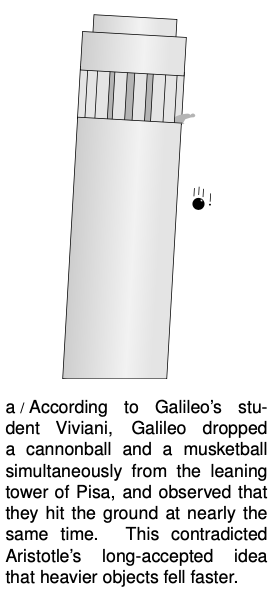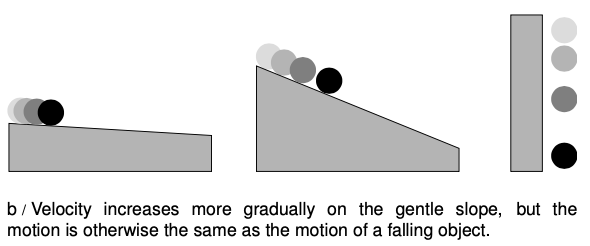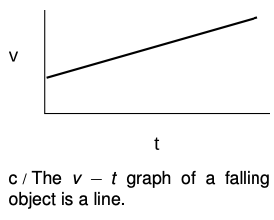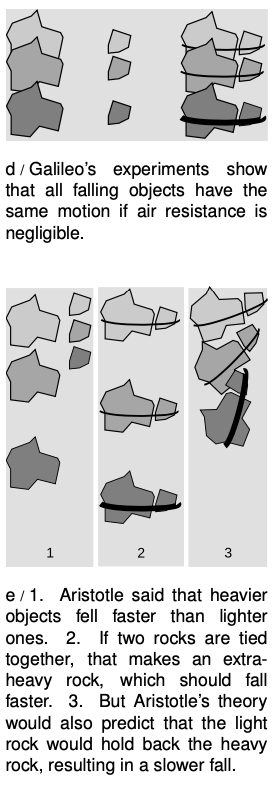3.1 The Motion of Falling Objects by Benjamin Crowell, Light and Matter licensed under the Creative Commons Attribution-ShareAlike license.
3.1 The motion of falling objects
The motion of falling objects is the simplest and most common example of motion with changing velocity. The early pioneers of physics had a correct intuition that the way things drop was a message directly from Nature herself about how the universe worked. Other examples seem less likely to have deep significance. A walking person who speeds up is making a conscious choice. If one stretch of a river flows more rapidly than another, it may be only because the channel is narrower there, which is just an accident of the local geography. But there is something impressively consistent, universal, and inexorable about the way things fall.
 Stand up now and simultaneously drop a coin and a bit of paper side by side. The paper takes much longer to hit the ground. That's why Aristotle wrote that heavy objects fell more rapidly. Europeans believed him for two thousand years.
Stand up now and simultaneously drop a coin and a bit of paper side by side. The paper takes much longer to hit the ground. That's why Aristotle wrote that heavy objects fell more rapidly. Europeans believed him for two thousand years.
Now repeat the experiment, but make it into a race between the coin and your shoe. My own shoe is about 50 times heavier than the nickel I had handy, but it looks to me like they hit the ground at exactly the same moment.
So much for Aristotle! Galileo, who had a flair for the theatrical, did the experiment by dropping a bullet and a heavy cannonball from a tall tower. Aristotle's observations had been incomplete, his interpretation a vast oversimplification.
It is inconceivable that Galileo was the first person to observe a discrepancy with Aristotle's predictions. Galileo was the one who changed the course of history because he was able to assemble the observations into a coherent pattern, and also because he carried out systematic quantitative (numerical) measurements rather than just describing things qualitatively.
Why is it that some objects, like the coin and the shoe, have similar motion, but others, like a feather or a bit of paper, are different? Galileo speculated that in addition to the force that always pulls objects down, there was an upward force exerted by the air. Anyone can speculate, but Galileo went beyond speculation and came up with two clever experiments to probe the issue. First, he experimented with objects falling in water, which probed the same issues but made the motion slow enough that he could take time measurements with a primitive pendulum clock. With this technique, he established the following facts:
- All heavy, streamlined objects (for example a steel rod dropped point-down) reach the bottom of the tank in about the same amount of time, only slightly longer than the time they would take to fall the same distance in air.
- Objects that are lighter or less streamlined take a longer time to reach the bottom.
This supported his hypothesis about two contrary forces. He imagined an idealized situation in which the falling object did not have to push its way through any substance at all. Falling in air would be more like this ideal case than falling in water, but even a thin, sparse medium like air would be sufficient to cause obvious effects on feathers and other light objects that were not streamlined. Today, we have vacuum pumps that allow us to suck nearly all the air out of a chamber, and if we drop a feather and a rock side by side in a vacuum, the feather does not lag behind the rock at all.
How the speed of a falling object increases with time
Galileo's second stroke of genius was to find a way to make quantitative measurements of how the speed of a falling object increased as it went along. Again it was problematic to make sufficiently accurate time measurements with primitive clocks, and again he found a tricky way to slow things down while preserving the essential physical phenomena: he let a ball roll down a slope instead of dropping it vertically. The steeper the incline, the more rapidly the ball would gain speed. Without a modern video camera, Galileo had invented a way to make a slow-motion version of falling.

 Although Galileo's clocks were only good enough to do accurate experiments at the smaller angles, he was confident after making a systematic study at a variety of small angles that his basic conclusions were generally valid. Stated in modern language, what he found was that the velocity-versus-time graph was a line. In the language of algebra, we know that a line has an equation of the form `y=ax+b`, but our variables are `v`and `t`, so it would be `v=at+b` (The constant `b` can be interpreted simply as the initial velocity of the object, i.e., its velocity at the time when we started our clock, which we conventionally write as `v_o`.)
Although Galileo's clocks were only good enough to do accurate experiments at the smaller angles, he was confident after making a systematic study at a variety of small angles that his basic conclusions were generally valid. Stated in modern language, what he found was that the velocity-versus-time graph was a line. In the language of algebra, we know that a line has an equation of the form `y=ax+b`, but our variables are `v`and `t`, so it would be `v=at+b` (The constant `b` can be interpreted simply as the initial velocity of the object, i.e., its velocity at the time when we started our clock, which we conventionally write as `v_o`.)
self-check: An object is rolling down an incline. After it has been rolling for a short time, it is found to travel 13 cm during a certain one-second interval. During the second after that, it goes 16 cm. How many cm will it travel in the second after that?
(answer in the back of the PDF version of the book)
A contradiction in Aristotle's reasoning
 Galileo's inclined-plane experiment disproved the long-accepted claim by Aristotle that a falling object had a definite “natural falling speed” proportional to its weight. Galileo had found that the speed just kept on increasing, and weight was irrelevant as long as air friction was negligible. Not only did Galileo prove experimentally that Aristotle had been wrong, but he also pointed out a logical contradiction in Aristotle's own reasoning. Simplicio, the stupid character, mouths the accepted Aristotelian wisdom:
Galileo's inclined-plane experiment disproved the long-accepted claim by Aristotle that a falling object had a definite “natural falling speed” proportional to its weight. Galileo had found that the speed just kept on increasing, and weight was irrelevant as long as air friction was negligible. Not only did Galileo prove experimentally that Aristotle had been wrong, but he also pointed out a logical contradiction in Aristotle's own reasoning. Simplicio, the stupid character, mouths the accepted Aristotelian wisdom:
Simplicio:
There can be no doubt but that a particular body ... has a fixed velocity which is determined by nature...
Salviati:
If then we take two bodies whose natural speeds are different, it is clear that, [according to Aristotle], on uniting the two, the more rapid one will be partly held back by the slower, and the slower will be somewhat hastened by the swifter. Do you not agree with me in this opinion?
Simplicio:
You are unquestionably right.
Salviati:
But if this is true, and if a large stone moves with a speed of, say, eight [unspecified units] while a smaller moves with a speed of four, then when they are united, the system will move with a speed less than eight; but the two stones when tied together make a stone larger than that which before moved with a speed of eight. Hence the heavier body moves with less speed than the lighter; an effect which is contrary to your supposition. Thus you see how, from your assumption that the heavier body moves more rapidly than the lighter one, I infer that the heavier body moves more slowly.
What is gravity?
3.1 The Motion of Falling Objects by Benjamin Crowell, Light and Matter licensed under the Creative Commons Attribution-ShareAlike license.